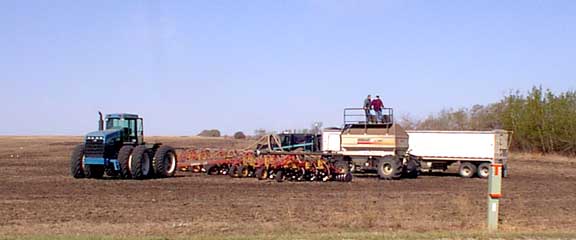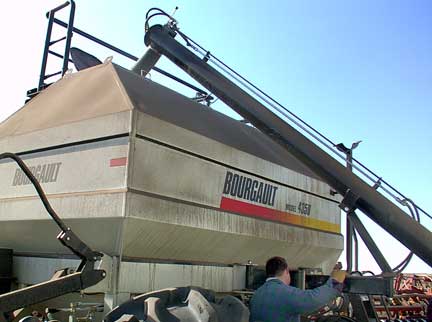|
Seeding the wind |
 |
| FTLComm - Tisdale - May 10, 2001 |
 To the clatter of hydraulic powered augers pumping wheat and fertilizer from the tractor trailer unit into the seed hopper the question was, "Has the wind been a problem?" As it turned out this farm operation had been prepared for drought, noting that there really has been no appreciable precipitation since July 2000 they did their anhydrous banding in the fall and are making one pass over to seed now so their fields have not been disturbed and the trash |
| cover appears to be doing |
 its job.
This field just its job.
This field justSouth of Tisdale opposite the Louis Dreyfus terminal is actually ideal for spring planting and germination. With the trash cover on this stubble field the soil is actually damp. However, not everyone has been this fortunate some fields had been worked up and one of their neighbours have seen their quart section of planted canola distributed by the high winds and they will have to repeat the planting process. I wonder if the folks at Monsanto will be after those seeds that will be soon to germinate miles from the site planted. In preparation for planting this field had been treated with Round-up to suppress weed development, rather than disturb the soil with |
| tillage equipment. |
 This farming operation will seed over four thousand acres this spring and will do it all with the one tractor and air seeder. The wind has been a factor inhibiting the application of chemicals but otherwise the seeding process appears to be moving along on schedule. |
| After we had our conversation the farmer mounted his pickup and went out to the last
pass by the seeding equipment to see that things were going into the ground according
to plan. I had asked him about the machinery and he explained something that is not obvious to a non-farmer. This huge tractor will only work a little more than three hundred hours this year and it was due for an oil change this afternoon (oil is changed every 250 hours). At that rate this quarter million dollar machine will last a very long time primarily because of the efficient use of chemicals and limiting the number of operations taken on the fields. This large farm operation has only the one one farm truck, a highway style tractor trailer unit and because of their size of operation have their own commercial type high wheeled sprayer. By simplifying the process and using large efficient machines this farm operation can cope with the excessive freight rates and elevation costs but even these are minimised as this operation has leased trackage for loading their own grain onto railcars thus saving themselves more. In the picture at the top of the page most of this massive farm's equipment is in that picture. The tractor, $125,000 air seeder, and semi grain hauler. The rest of the equipment includes the sprayer, utility tractor, swather, combine and the huge row of steel bins. Explaining his concern about the growing cost of transportation this farmer explained that when going through his input costs recently using the computer programme he uses for this task he was staggered at the amount spent in conveying his production. He maintains that despite the miserable weather when they were loading this winter it brought considerable returns. He pointed out that here in the Tisdale area we are at the end of the line, a surprising concept but he is right we are the furthermost producers from any market and we have the highest transportation costs in North America. |
 |